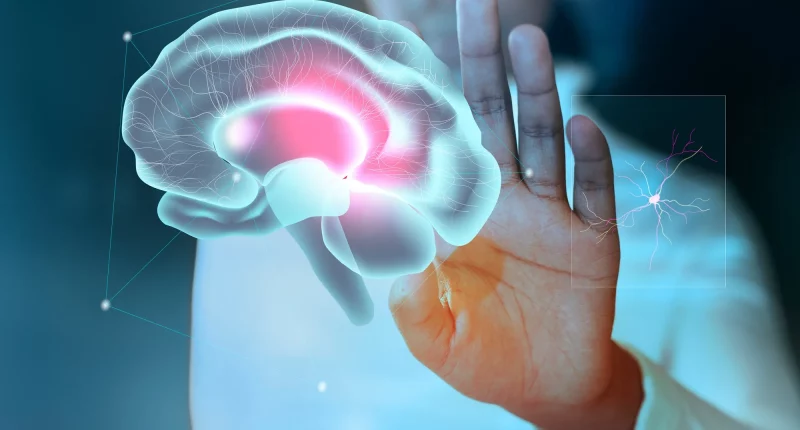Brain cancer occurs when abnormal cells in the brain grow uncontrollably. These cells cluster together to form tumors, which can vary in speed of growth—some are slow, while others grow quickly.
Treating brain cancer involves removing the tumor and targeting any remaining cells of cancer. Advances in treatments are enhancing survival rates, particularly for slower-developing tumors.
What is it?
Brain cancer, or primary brain cancer, happens when cells in your brain grow out of control and form masses known as brain tumors. This differs from cancer that starts elsewhere in the body and extends to the brain, which is called metastatic or secondary brain cancer.
Certain types of brain tumors can develop rapidly and disrupt normal body functions. They can be dangerous and require appropriate treatment once identified.
Brain cancer is relatively rare. As stated by the American Cancer Society, the likelihood of growing a cancerous brain tumor in one’s lifetime is less than 1 percent.
Symptoms
Symptoms of brain cancer can vary depending on the location and size of the tumor. In its early stages, brain cancer may present symptoms similar to less severe conditions. While many of these symptoms are common and often not related to brain cancer, it’s important to take notice if they persist for more than a week, appear suddenly, do not respond to over-the-counter medicines, or cause significant concern.
Typical symptoms of brain cancer include headaches, especially worsening in the morning, a sick feeling of stomach, vomiting, impaired coordination or balance, trouble walking, memory problems, trouble concentrating, speech difficulties, vision changes, abnormal eye movements, personality changes, muscle twitching or jerking, unexplained fainting, drowsiness, tingling or numbness in the limbs, and seizures.
Early detection plays a crucial role in improving the prognosis of brain cancer. If you experience these symptoms regularly or suspect they may be related to a more serious issue, it is advisable to seek medical evaluation promptly. This can help ensure timely diagnosis and appropriate treatment.
Causes and Risk Factors
The exact reason why primary brain cancer develops is not known. However, research indicates a correlation between high amounts of ionizing radiation exposure and a raised chance of developing brain cancer. Common sources of ionizing radiation include regular medical imaging tests like X-rays and CT scans, and radiation therapies.
Other factors that may contribute to the getting of brain cancer include advancing age, a genetic history of brain cancer, smoking, and exposure to certain chemicals like pesticides, fertilizers, and herbicides. Occupational exposure to substances like rubber, plastics, lead, petroleum products, and certain textiles may also play a role. Additionally, having had an infection named Epstein-Barr virus, commonly associated with mononucleosis, is considered a potential risk factor.
Secondary brain cancer, which occurs when cancer from another area of the body extends to the brain, is more commonly associated with specific types of primary cancers. These include breast cancer, lung cancer, bladder cancer, kidney cancer, and melanoma (a kind of skin cancer) among others. Understanding these risk factors can aid in preventive measures and early detection efforts for both primary and secondary brain cancers.
Diagnosis
Diagnosing brain cancer typically involves several diagnostic procedures if symptoms suggest the presence of a brain tumor. Initially, a neurological test helps assess any impact the tumor may have on brain function. Imaging tests like CT scans, MRI scans, and positron emission tomography scans are then used to pinpoint the location and size of the tumor.
In some cases, a lumbar puncture (also called a spinal tap) may be performed to collect a tiny sample of the cerebrospinal fluid surrounding the spinal cord and brain. This sample is analyzed to identify any cancer cells that may indicate the presence of brain cancer.
For a definitive diagnosis and to determine whether the tumor is malignant, a brain biopsy may be necessary. This surgical procedure involves removing a small portion of the tumor tissue for detailed examination under a microscope.
Each of these diagnostic methods plays a crucial role in accurately identifying brain cancer and guiding appropriate treatment decisions. Early and precise diagnosis is vital in improving outcomes for individuals with brain tumors.
Treatment
Treatment options for brain cancer vary depending on whether it’s primary or metastasized from another site. The approach taken considers factors such as the size, type, and place of the tumor, as well as the patient’s age and overall health.
The main treatments for brain cancer include surgery, radiation therapy, chemotherapy, combination therapy using both chemotherapy and radiation and biologic drugs that enhance the body’s natural defenses against cancer. Surgery is often the first line of treatment to remove as much of the tumor as possible, depending on its location and accessibility.
Chemotherapy involves medications that can shrink tumors and destroy cancer cells in the brain, administered orally or intravenously. Radiation therapy utilizes high-energy waves like X-rays to target and eliminate tumor tissue that cannot be surgically eliminated.
Biologic drugs, such as immunotherapy, are designed to bolster the immune system’s ability to combat cancer cells specifically. Other medications may be prescribed to manage symptoms and side effects resulting from the tumor or its treatment.
In cases where standard treatments prove ineffective, clinical trials may offer experimental therapies that are still under investigation. These trials can include innovative approaches like immunotherapy trials or CAR T cell therapy trials, aimed at advancing treatment options for advanced brain cancer.
Rehabilitation may be necessary to help patients regain lost abilities due to the tumor or its treatment, involving occupational therapy, physical therapy, and other rehabilitative measures.
While alternative therapies like dietary changes or supplements are sometimes recommended, their effectiveness in treating brain cancer is not well-supported by scientific evidence. It’s crucial to discuss any alternative treatments with your healthcare provider before making changes to your regimen.
Outlook
The outlook for brain cancer can be daunting, but advancements in treatments and ongoing research are improving outcomes and increasing survival rates for patients.
Survival rates for brain cancer differ widely depending on factors like the type of tumor, your age when diagnosed, and the cancer stage. For example, meningiomas, the most frequent type of brain tumor in adults, show a five-year survival rate of 84% for adults aged 20 to 44, and 74% for those aged 55 to 64.
It’s important to note that these survival rates are based on historical data, and current rates are likely even better due to medical progress. Your healthcare provider can provide more specific information about the stage of your brain tumor and your individual prognosis. This personalized discussion can help you understand what to expect and how best to approach treatment and care.
Summary
Brain cancer occurs when abnormal cells in the brain form tumors, impacting functions like coordination, memory, and vision. Diagnosis involves neurological exams, imaging tests, and sometimes biopsies to confirm cancer presence and type. Treatment options include surgery, chemotherapy, radiation therapy, and biologic drugs, with rehabilitation often necessary for recovery. Factors influencing prognosis include tumor type, size, and patient age, with ongoing research improving survival rates. Despite the challenges, advancements in treatments are offering more hope to patients, enhancing outcomes and quality of life. Regular medical monitoring and early intervention are crucial for managing brain cancer effectively.








